Everybody’s got the Justice Society on the brains these days — including columnist Paul Kupperberg…
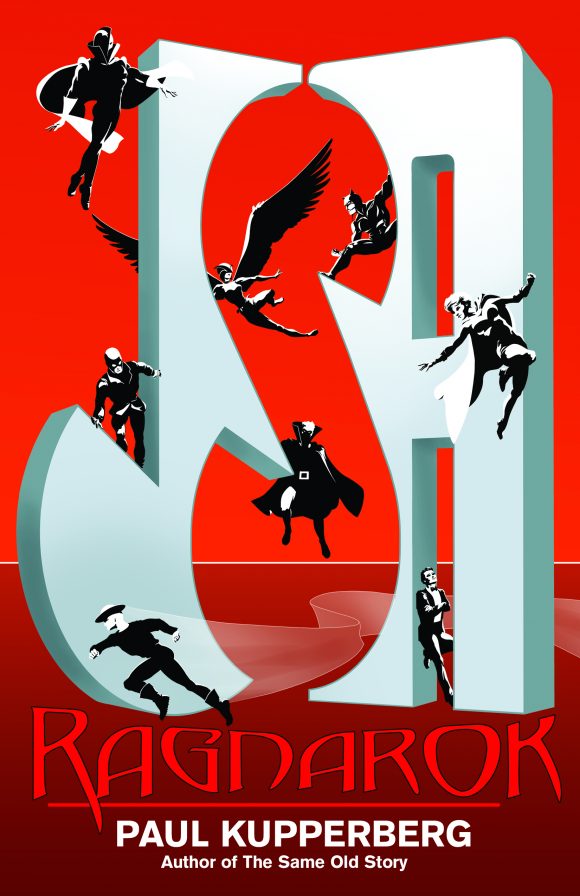
By PAUL KUPPERBERG
Everything old is new again, and at the moment, the good old Justice Society of America seems to the hot new old thing in comics media, from their spotlight role in the TV show Stargirl to their starring in the upcoming animated movie, Justice Society: World War II. And, of course, in the pages of my Crazy 8 Press novel, JSA: Ragnarok (now available on Amazon.com or get signed and personalized copies direct from me. (Click here.)
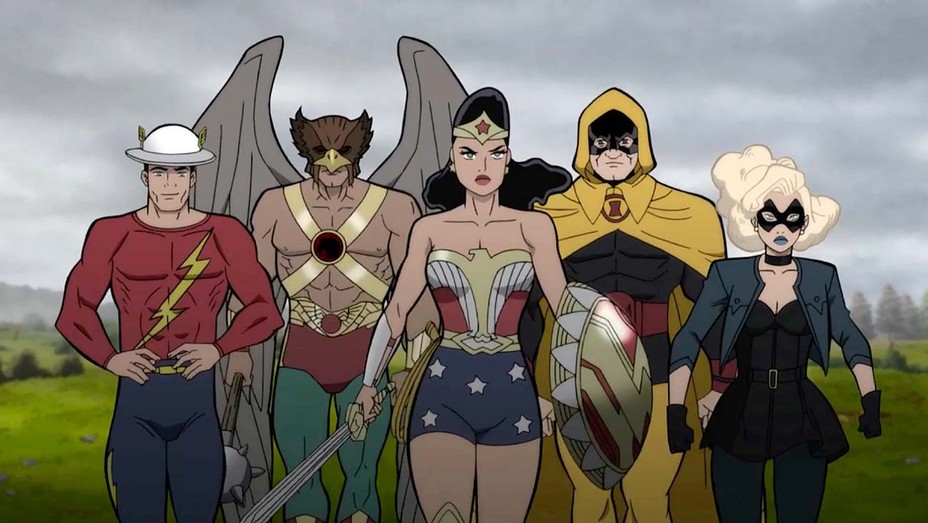
Justice Society: World War II
Writing the JSA (beyond a couple of 1980s fill-in dialogue jobs I did over Roy Thomas’ plots in All-Star Squadron) was one of those fan-boy bucket list gigs. My love for the Golden Age team in general and certain characters in particular (the Jay Garrick Flash and Wildcat, for example) goes deep and dates back to the very dawn of my obsession for 1960s DC Comics, especially those edited by Julie Schwartz.
Because, as fate would have it (>gasp! choke!<), DC’s Multiverse and I share a birthday! It’s right there, in Panel 1 of Page 6 of “The Flash of Two Worlds” in The Flash #123 (by Gardner Fox, Carmine Infantino, and Joe Giella): Barry Allen accidentally vibrated so fast that he “passed through some sort of space warp” into what he quickly realized was a different place from where he started. Passing a newsstand, he picks up a copy of the Keystone City Herald and learns from the newsie that he is indeed no longer in his own Central City.
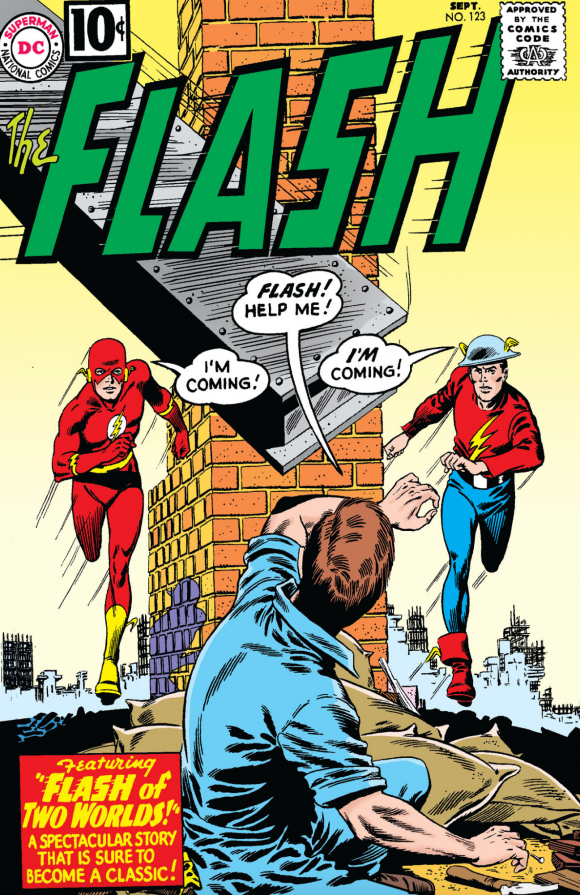
The date on the newspaper is June 14, 1961. My birthday is June 14! And the concept of what happened, as explained by Barry to Jay Garrick was just too unbelievably mind blowing: “The way I see it, I vibrated so fast — I tore a gap in the vibratory shields separating our worlds! As you know — two objects can occupy the same space and time — if they vibrate at different speeds!” Barry then goes on to hypothesize that “Gardner Fox,” the writer of the 1940s Jay Garrick Flash comic book stories Barry read as a kid, was somehow psychically tuned into this parallel Earth and “dreamed” the stories.
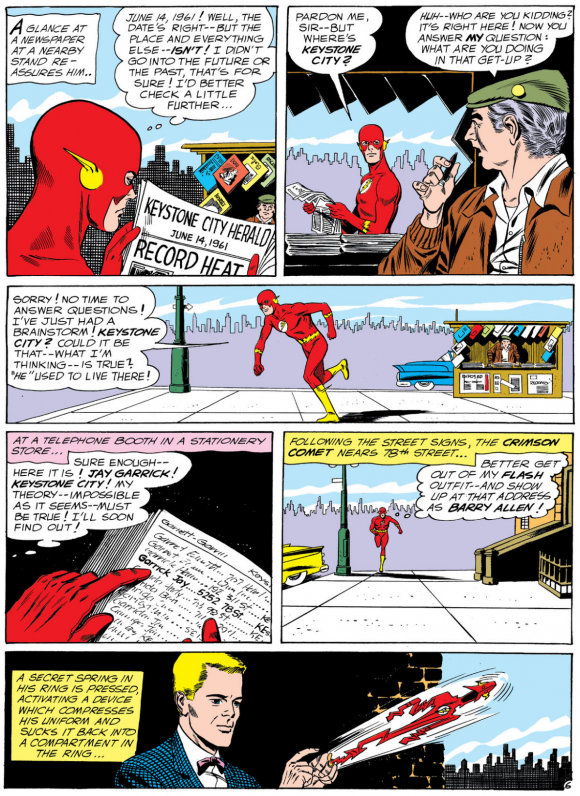
I didn’t see that 1961 tale until several years later, in 1966, reprinted in a Flash Annual, but the story sealed the deal for me. Especially as that reprint opened my eyes to the existence of other stories that had been published since then, featuring not only Jay Garrick but scads of other 1940s Golden Age heroes in Justice League of America, The Brave and the Bold and other titles.
To you guys in 2021, all of this stuff is history. Ancient history, gone and blowed up real good in Crisis on Infinite Earths and all the Crises that have followed. But to readers in the 1960s, this was a slowly evolving series of often epic events, a bunch of individual threads being woven together before our very eyes into what would soon become the majestic tapestry known as the Multiverse. But first they were called “parallel universes,” worlds very much like our own but with differences.
Here, in chronological order, are my 13 FAVORITE 1960s DC MULTIVERSE CROSSOVER STORIES:
—
1. Showcase #4 (Sept.–Oct. 1956). Without even realizing it at the time, editor Julie Schwartz and writer Robert Kanigher set the stage in this landmark issue’s “Mystery of the Human Thunderbolt” for a revolution in DC Comics whose effects are still being felt today. Showcase #4’s introduction of a new version of a classic character is not only recognized as one of the signposts of the superhero rebirth of the Silver Age, but it also established a direct lineage from the “new” Flash to the “old.”
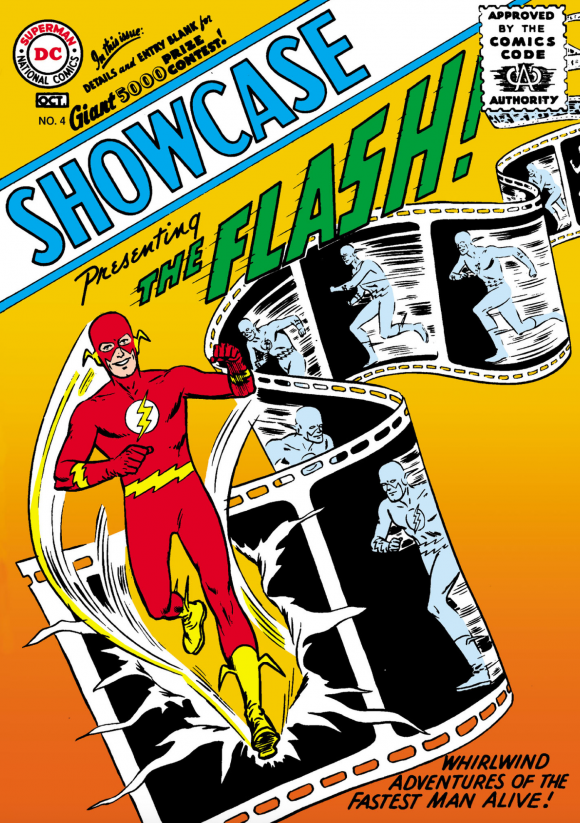
Just before the laboratory accident that gives him superspeed, police scientist Barry Allen is shown reading an old issue of Flash Comics, pondering the crime fighting potential of superspeed. “Well… I’ll never know — the Flash was just a character some writer dreamed up!” Two panels later, lightning struck, and the very first seed of the Multiverse was planted in the embryonic DCU.
—
2. The Flash #123 (July 1961). Some seeds take longer than others to germinate. In the case of the Multiverse, the first sprout didn’t break ground for almost five years. In a mid-1990s career spanning interview I conducted with Julie — and excerpted in the introduction I wrote for the Silver Age section of The Flash: 80 Years of the Fastest Man Alive (DC Comics, 2019) — he remembered coming up with the concept for “Flash of Two Worlds” as an almost throwaway bit, just another pseudoscientific Schwartzian gimmick to fill 25 pages:
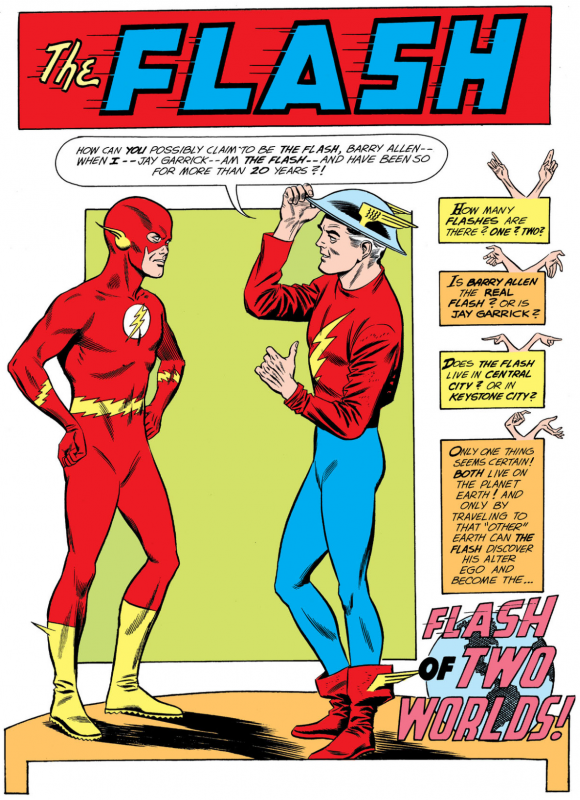
“I was plotting the story with Gardner Fox when I remembered the idea that Barry Allen (had been) inspired by a comic book character he read as a kid. We took it several steps farther, having the Flash visit the Flash of the comic books he used to read, who was ‘real,’ but living on a different Earth. Gardner and I licked the plot right then and there, coming up with the concept of parallel Earths, having the Golden Age Flash reside on what we now called Earth-Two, the Earth where all the Golden Age characters existed.”
D’oh!
—
3. The Flash #137 (June 1963). Jay Garrick was back a couple of years later, this time “featuring a thrilling guest appearance by the Justice Society of America” in the “Vengeance of the Immortal Villain.”
While it takes Barry a major leap of logic to get there, he decides the answer to a mystery he’s confronting may just lie with Earth-Two: “I was right! The city where the sky-lights appeared — are cities on the other Earth where the members of the former Justice Society of America resided!”
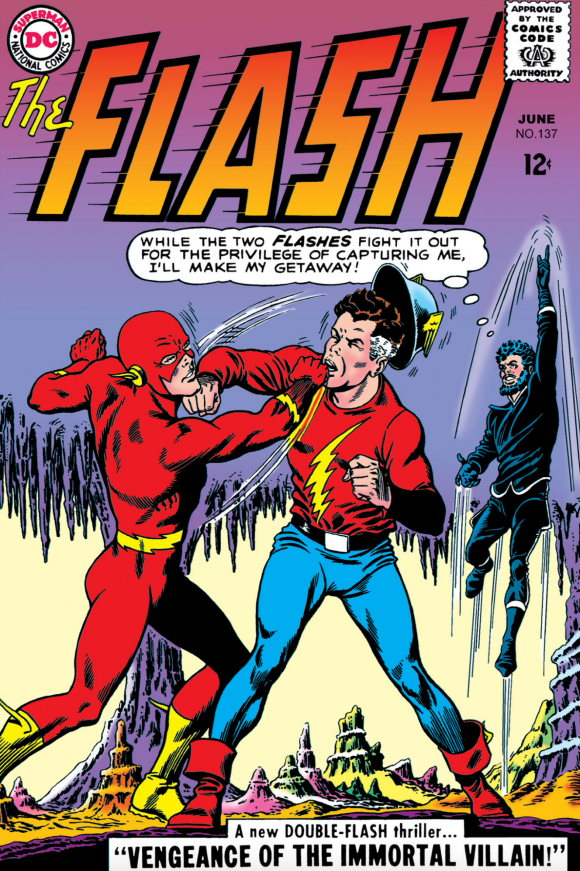
The Immortal Villain is, of course, Vandal Savage, who spends several pages talking to himself, recapping not only his own origin for himself, but also regaling himself with how clever he was in luring the JSA out of retirement and capturing them. The JSA’s role is confined largely to that of hostages held in suspended animation, but once the two Flashes take care of that problem and Savage is sent back to prison, Earth-Two Wonder Woman suggests, “It might be a good idea for us to meet every so often — come out of retirement, as it were — to prevent anything like this from happening again!” Hawkman says, “We’ll contact Flash and set a date for a future meeting!”
—
4. Justice League of America #21–22 (Aug.–Sep. 1963). That date would be made just a couple of months later, in the pages of the unofficial successor magazine to the Golden Age JSA’s All Star Comics, the Justice League of America. Though the JSA’s line-up in “Vengeance of the Immortal Villain” (Flash, Dr. Mid-Nite, Wonder Woman Hawkman, Atom, Johnny Thunder and Green Lantern) was slightly amended for “Crisis on Earth-One” and “Crisis on Earth-Two” (to Hawkman, Flash, Atom, Green Lantern, Black Canary, Hourman and Dr. Fate) by Fox, Mike Sekowsky and Bernard Sachs, it was still a monumental event.
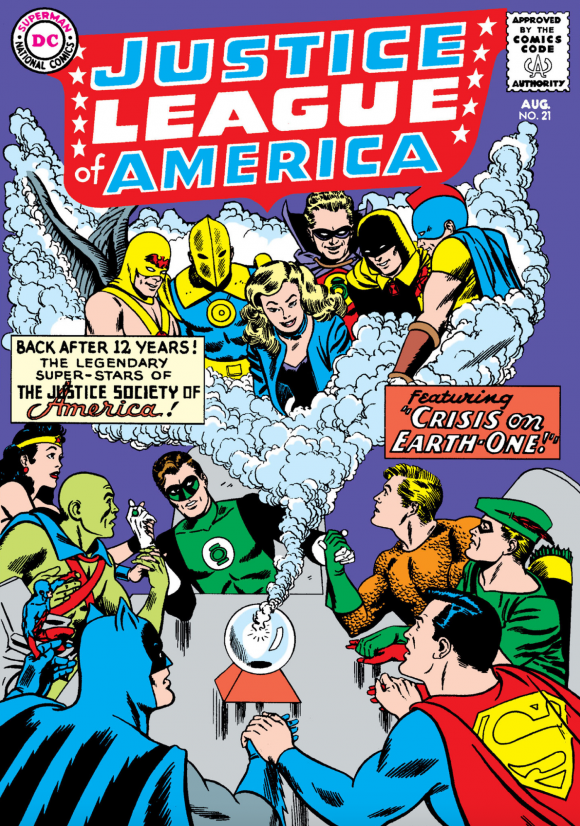
In opposition to the teams? The so-called Crime Champions, consisting of six “modern” Earth-One bad guys (Chronos, Felix Faust, and Dr. Alchemy) teamed up with Golden Age villains the Wizard, the Fiddler and Icicle. The good guys win (in those days, they had to… Comics Code Authority insisted!), but the story ends with Hawkman telling the others, “We’re going to keep in touch! There’s no telling when we may be called upon to join forces again!”
I’ll tell you when! Every year, same Bat-time, same Bat-station, for the foreseeable future!
—
5. Justice League of America #29-30 (Aug.–Sept. 1964). What comes after Earth-Two? Earth-Three, home to the Crime Syndicate of America: Ultraman, Superwoman, Owlman, Power Ring and Johnny Quick!
“Crisis on Earth-Three” and “The Most Dangerous Earth of All!” were something altogether new for me: evil analogues of the heroes from a world where everything was topsy turvy: “Colonial England won her freedom from the United States in the Revolutionary War of 1776… and it was actor Abraham Lincoln who shot President John Wilkes Booth!” Besides that, I thought Ultraman was just too awesome.
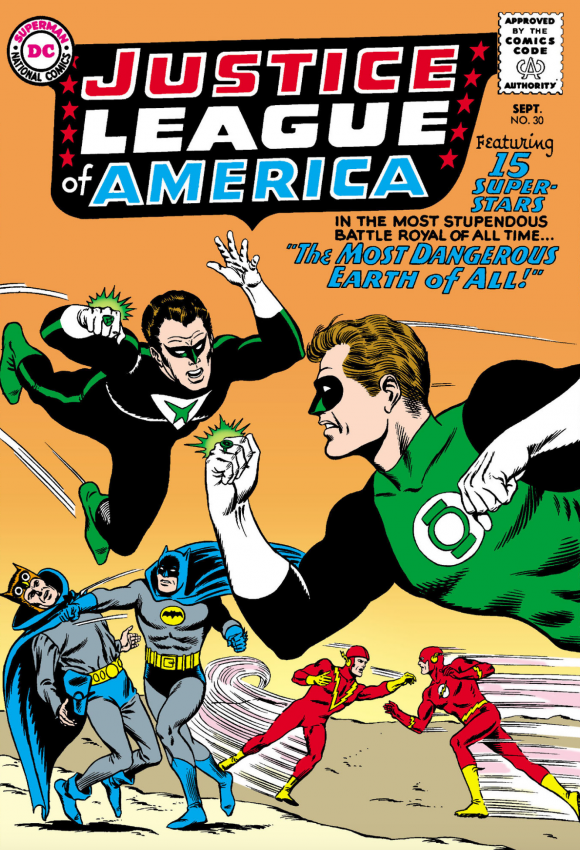
Anyway, it took the combined might of the JLA and JSA (now joined by the original Ted Knight Starman) to bring down the Syndicate, but they would, thankfully, be back. Delayed gratification bonus cool: The Crime Syndicate got their own action figure line in 2002; I had two of the Ultraman. One NIP, the other to play with.
—
6. Showcase #55–56 (March/April–May/June 1965). It was back to the title where the first seeds of the Multiverse were strewn for some pure Earth-Two goodness and the start of what might have been an effort to boost the visibility and popularity of the Golden Age heroes by featuring them in issues of Showcase and The Brave and the Bold.
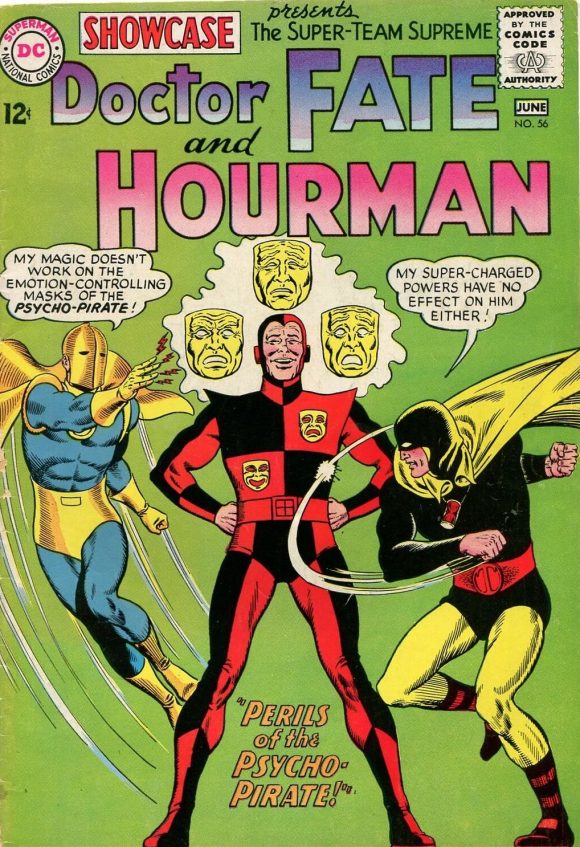
Beginning with pairing of Dr. Fate and Hourman in the two-issue “Solomon Grundy Goes on a Rampage” and “Perils of the Psycho-Pirate” by Gardner Fox and artist Murphy Anderson, there would be six months more or less straight of Golden Age heroes appearing on the newsstand. What were they hoping for? Sales that would justify the return of a new Justice Society of America title?
Earth-Two fans can only dream.
—
7. The Brave and the Bold #61-62 (August/September-October/November 1965). It seems kind of random in retrospect to team up Black Canary and Starman. The JSA aside, they really didn’t have much in common, but Ted Knight’s surprise “Hi, I just happened to be in the neighborhood” appearance at Dinah Lance’s flower shop is all the excuse the duo needs to mutually stumble across the crimes of Golden Age baddies Sportsmaster and the Huntress and have at it.
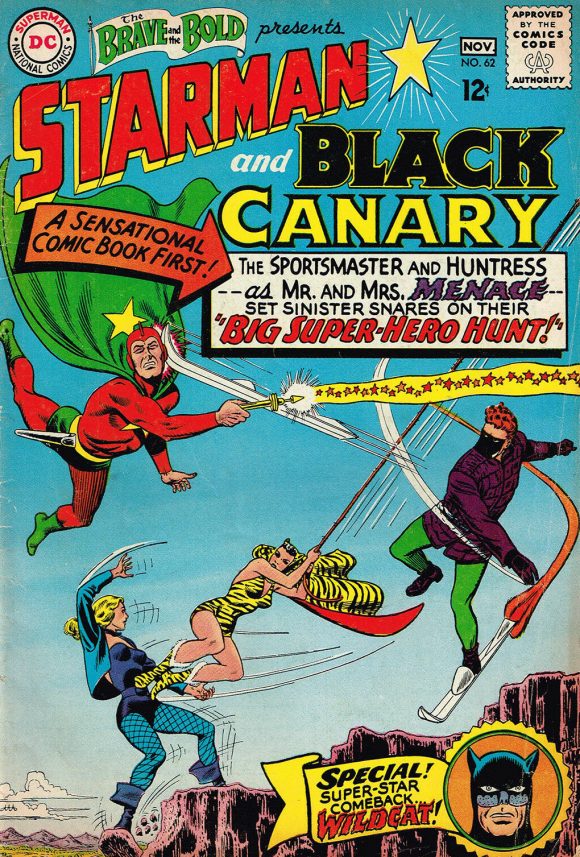
Written by Fox, with art by Murphy Anderson, “The Big Super-Hero Hunt” features special guest-star Wildcat, and, as a bonus, includes his boxing match with a kangaroo, as well as Black Canary’s fight with a gorilla.
—
8. Showcase #60–61 (January/February–March/April 1966). The Spectre made his Silver Age debut in the last of the Earth-Two “try-out” books — the only one to lead to an ongoing title… eventually; Spectre #1 was cover-dated Nov.-Dec. 1967 and the series would only last 10 issues.
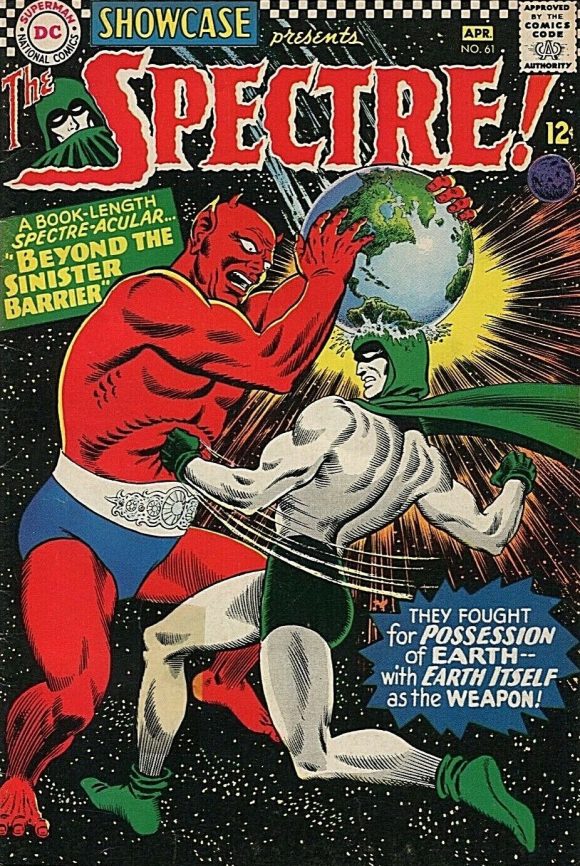
But “The War That Shook the Universe” and “Beyond the Sinister Barrier,” yet another Fox and Anderson production, showed every sign of being a potential Silver Age hit. Neither issue pinpoints the world on which the stories take place, but there was nothing to suggest this was anything but a continuation of the Golden Age character.
—
9. Justice League of America #37–38 (Aug.–Sept. 1965). OK, so Earth-Two Johnny Thunder orders the Thunderbolt to introduce him to the Earth-One Johnny Thunder. But guess what? The Earth-One Johnny Thunder is a no-good crook who, unfortunately, isn’t anywhere near as dumb as his Earth-Two counterpart so he quickly figures out how to take control of the Thunderbolt and use it for evil.
Got that?
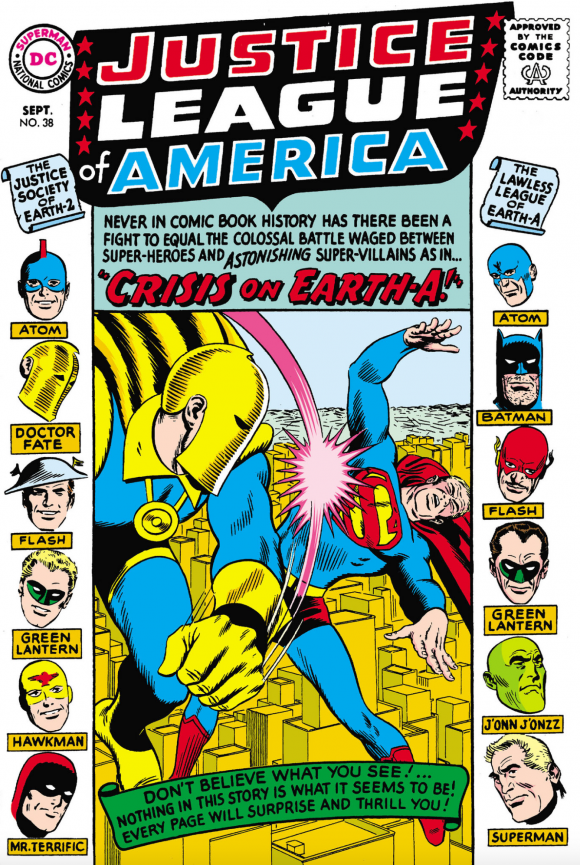
“The Earth — Without a League” and “Crisis on Earth-A” (which includes the Thunderbolt’s magically created “Lawless League,” unshaven thugly versions of the JLA) is a fun romp that, like the earlier Earth-Three, not only continues to expand the Multiverse, but even has some fun with the concept with its evil “what if?” versions of the superheroes.
—
10. Green Lantern #45 (June 1966). Schwartz is still the guiding editorial hand, but now writer John Broome joins the Multiverse fun in “Prince Peril’s Power Play,” bringing together the Green Lanterns from both Earths in one adventure.
Featuring some great art (like we should be surprised) by Gil Kane and Sid Greene, it’s the Earth-Two Green Lantern, Alan Scott, and his cab driver pal Doiby Dickles who commands the first half of the story. Hal Jordan doesn’t make his appearance until Page 12.
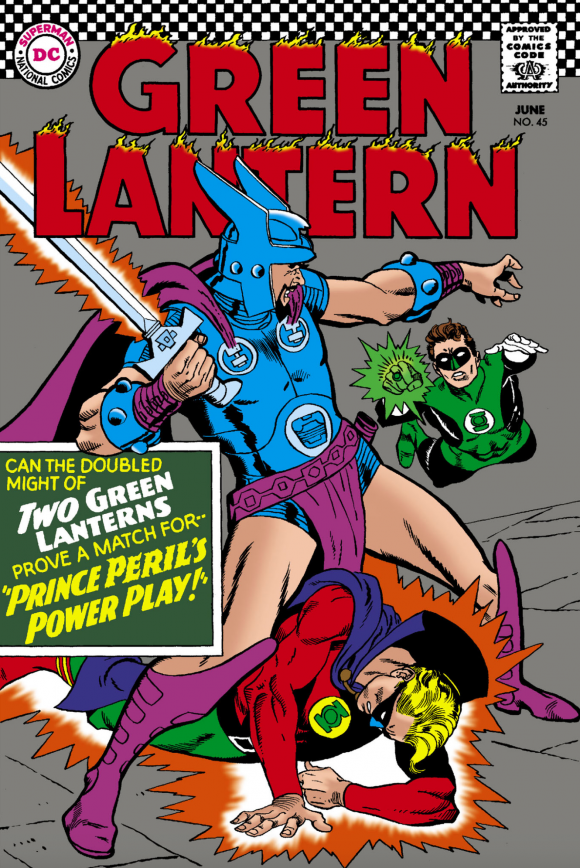
It may also be the first hint of Earth-Prime, the Earth on which we live and all the comic books we’re reading are published; at the end, penciler Gil Kane breaks the fourth wall to address the reader and tell us the real, happily-ever-after ending of the story.
—
11. The Atom #29 (February/March 1967). It was the Thinker of Earth-Two who thought to monetize the Multiverse by crossing the dimensional barrier to commit “The Thinker’s Earth-Shaking Robberies” on Earth-One, then return to his own dimension to enjoy his ill-gotten gains without having to worry about the cops, see? But it all goes wrong because telekinetic energy from a misadjusted doodad in his thinking helmet causes a reformed Earth-Two criminal to think exactly like him and commit the same crime on his own world, which the Earth-Two cops pin on the Thinker.
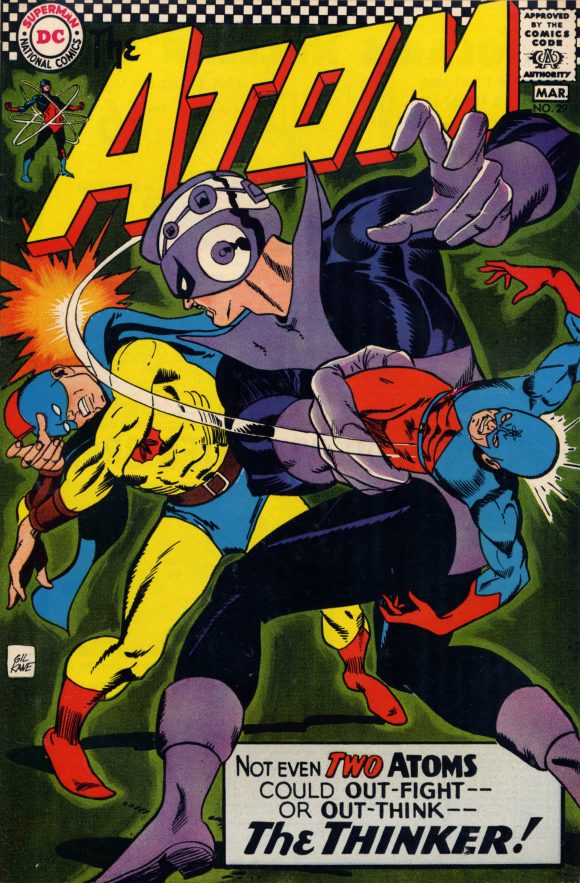
OK, the plots could get convoluted in these Schwartz titles, but the point is, Earth-One Atom encounters the Thinker in the commission of his interdimensional crime while the Earth-Two Atom (Al Pratt) is the mentor of the reformed crook telekinetically forced to duplicate the Thinker’s crime, and this Multiverse crossover is made not to combine forces against some overwhelming menace, but to solve the theft of a bunch of “priceless bookends.”
Was the barrier between the dimensions getting easier to breach?
—
12. Green Lantern #52 (April 1967). In answer to the above question: It was sure starting to look that way! Because the very next month, Hal Jordan visited Alan Scott on Earth-Two for breakfast and, only incidentally, the epic of “Our Mastermind the Car” (a take-off, no doubt, on the title of that 1965 classic of sitcom awfulness, My Mother the Car).
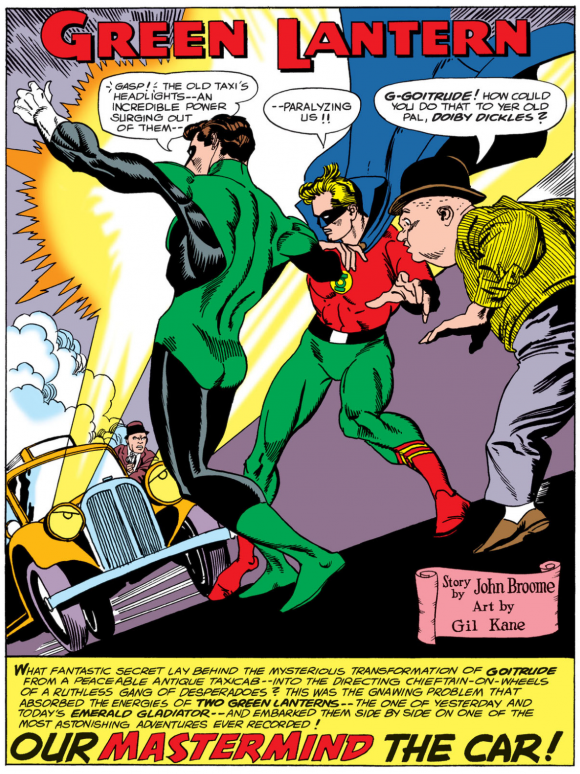
The car is “Goitrude,” the 1940s taxicab belonging to Scott’s 1940s comedic sidekick, Doiby Dickles. Alan’s been storing it in his garage ever since Doiby went to live on the far-off world of Myrg to be with his beloved bride, Princess Ramia (it happened in the earlier crossover in GL #45), but now it’s gone missing. Because, as 1940s taxicabs do, Goitrude started talking and became the leader of a criminal mob. (OK, OK, it was Sinestro, whose mind somehow got trapped in the car. It happens!)
—
13. The Spectre #3 (March/April 1968). There’s a lot to love about “Menace of the Majestic Mastermind,” but it’s also a significant story in that it’s the first Earth-One/Earth-Two crossover not written and drawn by creators who had worked on the Earth-Two Golden Age characters during the actual Golden Age.
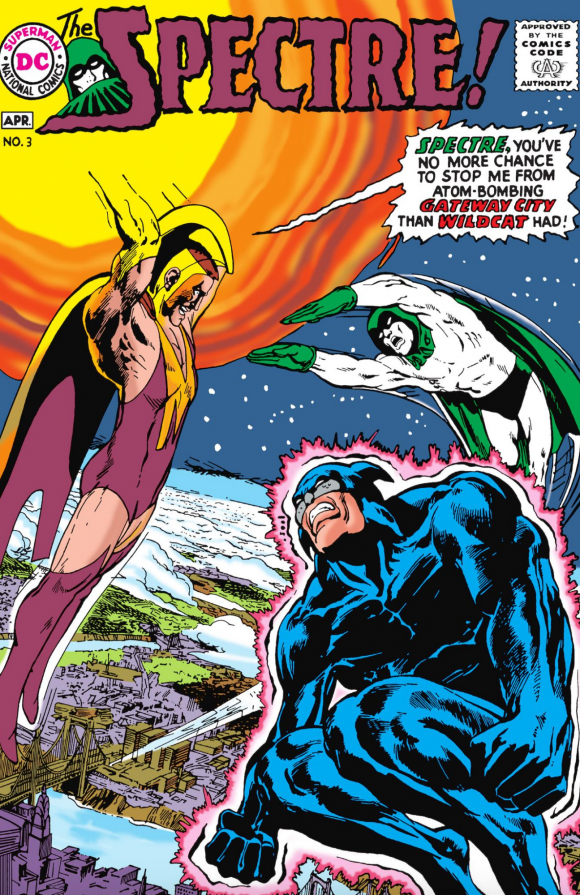
Julie Schwartz was still at the helm, of course, still the only editorial office playing in the Multiverse, and writer Mike Friedrich and artist Neal Adams were the relative new kids on the playground. Their focus didn’t seem to be so much on building on the Golden Age incarnations as giving the characters as a whole new coat of paint. Previously, one of the JSAers may have made a crack about the gray in their hair, but this Wildcat showed his creaking bones and the aches and pains of growing old.
Moving ahead, in the decades and incarnations of the JSA to come by writers ranging from Gerry Conway and Paul Levitz to Roy Thomas, age and mortality would become important factors in their stories, but it all started here.
***
Considering the importance Gardner Fox played in the building of the DC Multiverse, I want to leave you with these images, a sort of a “Separated at Birth” or perhaps more accurately “Separated by Dimensional Barriers” thing. On the left, writer Gardner Fox. On the right, the scientific theorist of the multiverse, Hugh Everett.
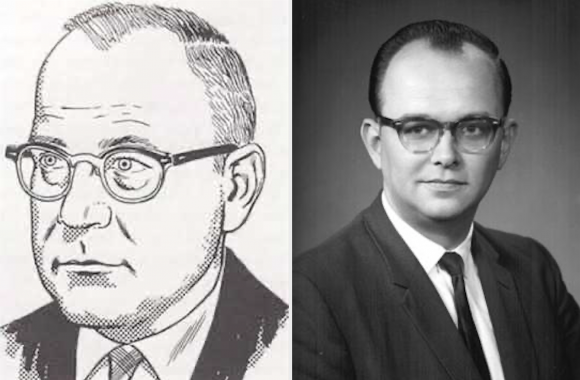
You be the judge.
—
Paul Kupperberg has been writing comic books from Archie to Zatanna for 45 years at DC, Archie, Charlton, Marvel, Bongo and others. He is also the author of Paul Kupperberg’s Illustrated Guide to Writing Comics (Charlton Neo Press); I Never Write for the Money… But I Always Turn in the Manuscript for a Check (Comics Career); the comic book industry-based murder mystery The Same Old Story, the short-story collection In My Shorts: Hitler’s Bellhop and Other Stories, and JSA: Ragnarok (all from Crazy 8 Press), all of which are currently — or shortly will be — available at Amazon.
—
MORE
— PAUL KUPPERBERG: My 13 Favorite DICK DILLIN JLA-JSA Crossover Stories. Click here.
— PAUL KUPPERBERG: My 13 Favorite MIKE SEKOWSKY Comics. Click here.

January 10, 2021
Great background, Paul!
I was sad after Crisis got rid of Earth 2–I thought that the JSA and all its characters worked better on a world of their own, instead of being merged with Earth 1 and shoehorned into that separate history.
I was hoping that when Metal was all finished that the JSA would be all back on a new Earth 2, but I guess that’s not going to be. I can still hope, though!
January 11, 2021
I agree with your assessment. I’ll go as far to add that they also work best set in the WWII setting of the 40s on a Earth-2.
January 21, 2021
That era was my golden age, and I so loved the DC cross-overs between Earth 1 and Earth 2
February 7, 2021
Point of order: Spectre #3 was most definitely NOT an ” Earth-One/Earth-Two crossover”, it was the Earth-Two Spectre AND Wildcat on the same Earth as referenced by the Justice Society mention in the story.
June 15, 2022
I loved Earth-Two! I was about twelve in the early 70s when I got a used Green Lantern (issue six or seven or so) where GL vibrates over to Earth-Two to hide from what seems to be a renegade Guardian, but is really the creation of Hector Hammond! (Lucky for Hal this was taking place at the time of year when travel across dimensions was easier!)